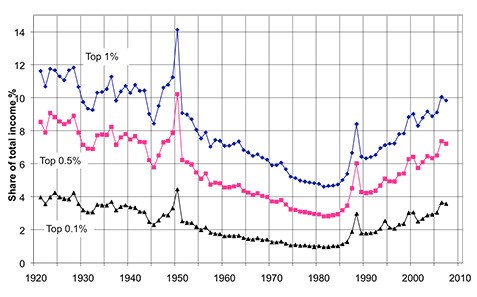The Occupy Wall Street movement, which has now well and truly gone global, has been criticised for its lack of a coherent message, above and beyond a collective railing at the unfairness of it all.
The same has been said of the small offshoot movement here in Australia, which turned out in numbers of around 600 and 500 in Sydney and Melbourne respectively over the weekend. Critics have questioned the need for such a movement in a country whose economy bears no similarity to the US and Europe.
Business Insider has helpfully graphed the many legitimate gripes at the heart of the US Occupy movement, starting with unemployment:

Yes, comparatively our unemployment rate would make the US weep with envy. But we are not immune to the gripes.
In his “Mind the Gap” piece for Inside Story published in May, economist and Labor MP Andrew Leigh wrote about the widening chasm between the haves and have nots in this country. Leigh cited research co-authored with Oxford’s Tony Atkinson, while he was an economics professor at the Australian National University, which examined how the income share of top income groups in Australia had changed, extending back to the 1920s:
In 1921 the top 1% of Australians had 12% of all household income. Then we saw a compression: the top earners’ income share steadily dropped until 1980, by which time that group had about 5% of all national income. Then we saw a rise again, and by 2007 the top 1% had 10% of household income, double the share in 1980.
We see an even starker pattern if we look at the top 0.1% — the richest 1/1000th of Australian adults. In 2007, members of this group were earning at least $693,000, and their income share of the Australian pie followed a similar trajectory. In 1921, they had 4% of all household income. That fell by 1980 to 1%, and then rose again so that, by 2007, the richest 1/1000th of all Australians again had 4% of household income.
The protesters here may not been driven by their own desperate circumstances the way protesters in the US and Europe are, but that doesn’t mean they don’t have legitimate questions to scrawl on their placards.








Occupy Protesters in Australia on Saturday had many diverse views but all agreed they are better off than protesters in other nations. Nevertheless, the range of grievances of protesters ranged from corruption, mining corporations and complicit governments chewing the **se out of Australia’s environment (including the mining of uranium), the brutal treatment of live exports, Aboriginal rights, renewable energy, mandatory detention to human rights abuses overseas and a whole host of other societal issues.
Occupy Perth intends to assemble in Forest Place from the time of the United March on CHOGM, October 28. The United March is calling for Justice and Climate action, not racism and war, and places itself in sympathy to the needs of the 99% in opposition to the agenda of the representatives of the 1% that are coming to Perth for CHOGM:
http://www.chogmprotest.org/post/277
They dont need a range of greivances.
Its the GOVERNMENT, thats failing the people